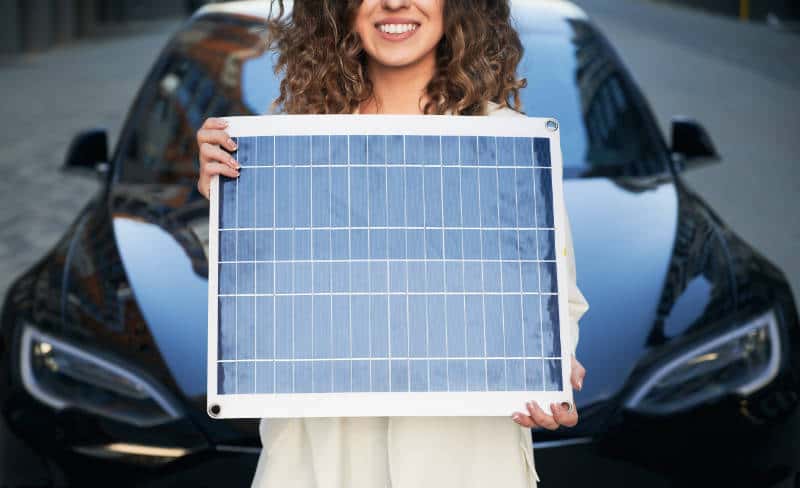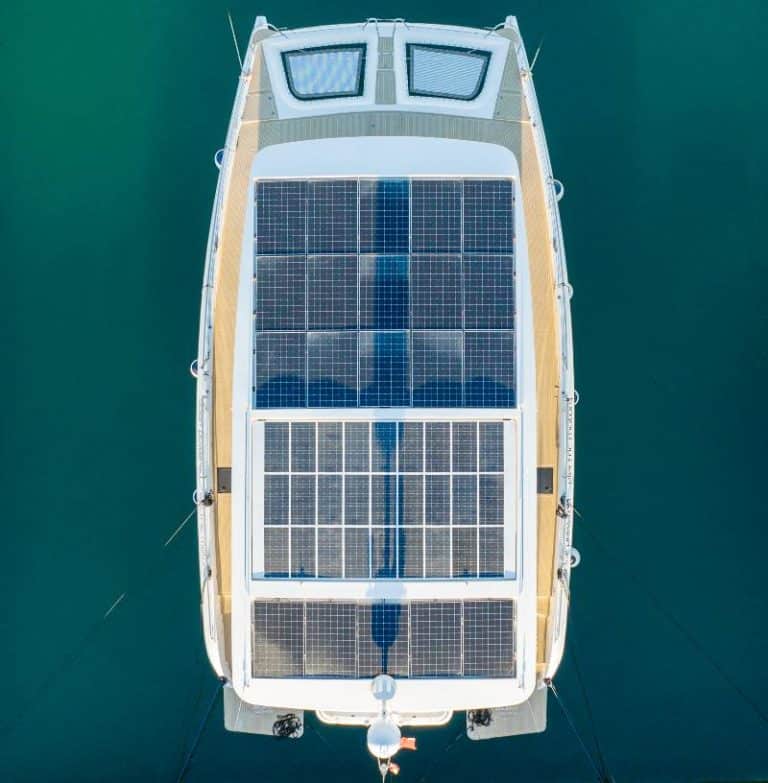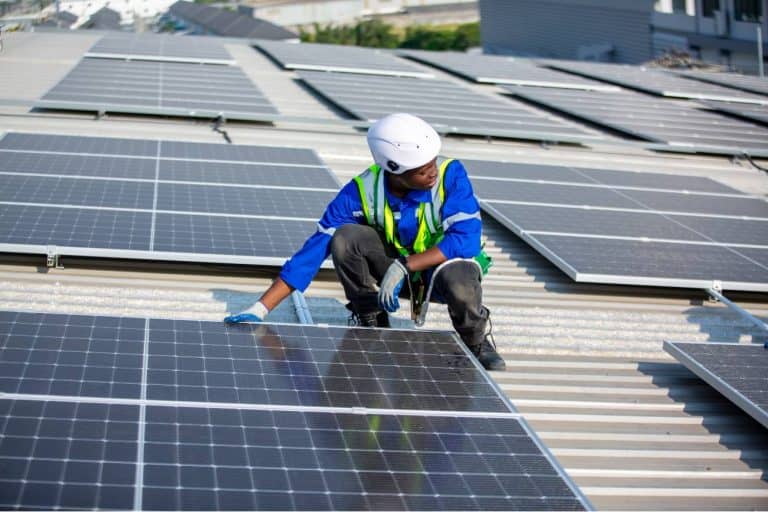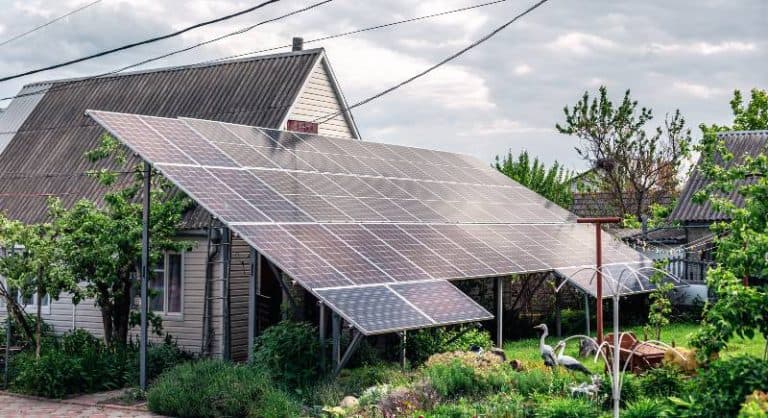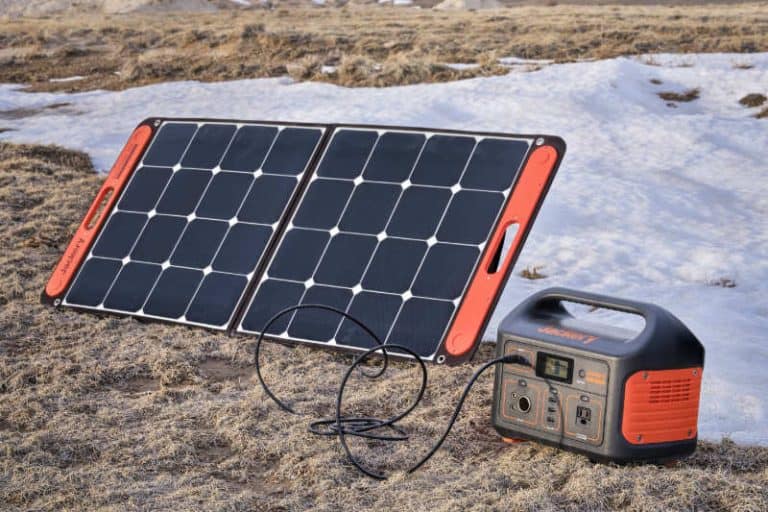Portable Solar Panel For Electric Car: Does It Work?
There is a lot of talk about solar energy these days, and for a good reason. It is a renewable resource that can help us reduce our dependence on fossil fuels. But did you know that you can use solar energy to power your car? This blog post will explore the possibility of using a portable solar panel for electric cars. Read on to learn more!
Portable Solar Panels for cars are a technology that can change the world for the better. As we know, solar power is one of the most popular energy sources in the world. It’s clean, renewable, and it’s free! You can use it to charge your car, phone, laptop, tablet, and any other portable solar panel device you want.
Key Takeaways
- If you have a large enough panel, it’s possible to power an electric car with portable solar panels—However, it is estimated that you would need anywhere from six to twelve solar panels to fully charge an electric car.
- The average capacity of a portable solar charger is about 18 watt-hours. This means that, in theory, you could charge a standard laptop fully in about two hours if the solar charger was placed in direct sunlight.
- The typical residential solar panel is about the size of a sheet of plywood, so if you want to fully pay off utility bills with solar, the average home needs between 20 and 24 solar panels.
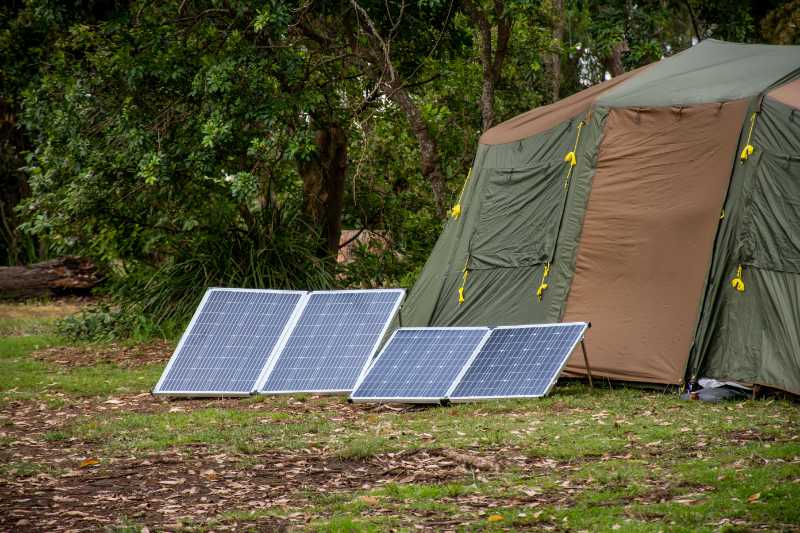
How many solar panels does it acquire to charge an electric vehicle?
The answer to this question is not definitive, as it depends on your car’s size and the solar panel’s efficiency. However, it is estimated that you would need anywhere from six to twelve solar panels to fully charge an electric car.
While portable solar panel technology may not be able to power your entire home, it can certainly help you reduce your dependence on fossil fuels.
Fossil fuels are non-renewable resources that come from the remains of plants and animals that lived millions of years ago. They were buried over millions of years and then, under the right conditions, heated and compressed to form liquids, solids, and gases. When we use fossil fuels, It is important to remember that we are using up the Earth’s natural resources very quickly—We cannot replace them at the rate we are using them now.
Our global economy is built to run on fossil fuels. They’re the power source behind most of what we do, from our homes to our cars, and from the agriculture, we depend on to the jobs we work. But burning those fuels isn’t good for the planet; it causes pollution like carbon and methane that gravely impact the weather and climate – in short, it causes climate change. We have alternatives to fossil fuels now, though. Solar powers are ready to step in, but the future potential of renewable energy is even more exciting.
Capacity Of Portable Solar Chargers
The average capacity of a portable solar charger is about 18 watt-hours. This means that, in theory, you could charge a standard laptop fully in about two hours if the solar charger was placed in direct sunlight. However, the actual charging time will be much longer because most devices do not operate at 100% efficiency. In other words, you will need to leave your device plugged in for longer than two hours to get a full charge.
Is It Possible To Charge Electric Cars With Solar Chargers?
Yes, it is possible to charge electric cars using solar chargers. Solar chargers use solar panels to convert sunlight into electricity, which can then be used to charge the batteries of electric cars. This is a clean and renewable way to power electric vehicles, and it can help reduce reliance on fossil fuels.
The amount of time it takes to charge an electric car using a solar charger will depend on a few factors, including the size of the solar panels, the efficiency of the charger, the size of the car’s battery, and the amount of sunlight available. In general, it will take longer to charge an electric car using a solar charger than it would use a traditional electric car charger, but the exact amount of time will vary.
How To Charge An Electric Car?
To charge an electric car with a solar charger, you will need to purchase a special adapter that converts the DC power from the solar charger into AC power. This AC power can then be used to charge the car’s battery.
A power inverter also called an inverter, is an electronic device or circuit that alters direct current (DC) to alternating current (AC). It turns DC power from a battery into standard AC power that you can use to run all kinds of devices, like electric lights, kitchen appliances, microwaves, power tools, TVs, radios, and computers, to name a few. In mundane terms, AC power is the form of electricity that your home and electric vehicle use. You can just plug your AC devices into the inverter and connect them to a battery–then you can use power wherever and whenever you want.
If you already have a solar system, you only need to buy an electric vehicle charging station. It will send electricity from your solar panels to your electric automobile via a charging port.
Can you charge a Tesla vehicle with a portable solar panel?
You can’t charge a Tesla with a portable solar panel. The amount of energy needed for an electric vehicle far exceeds enough energy production of a single panel.
Solar panels are not able to generate enough power to completely charge a Tesla on their own. However, solar panels can be used to supplement the charging of your Tesla and reduce your reliance on fossil fuels.
If you are interested in using solar power to charge your Tesla, we recommend that you consult with a solar energy specialist to determine the best system for your needs.
How Much Is Energy Needed To Charge Electric Cars Like Tesla?
The amount of energy needed to charge an electric car can vary depending on the size of the battery. For example, a Standard Tesla Model S has a 100 kWh battery and will consume about 27 kWh to travel 100 miles. This means that it would cost about $0.03 per mile to drive if electricity costs ¢11 per kilowatt-hour.
In contrast, a Tesla Model X has a larger battery (100 kWh) and will consume about 54 kWh to travel the same distance. This means that it would cost about $0.06 per mile to drive if electricity costs ¢11 per kilowatt-hour.
As you can see, the cost of driving an electric car can vary depending on the size of the battery and the cost of electricity. However, electric cars are still much cheaper to operate than gas-powered cars.

How to charge an electric vehicle with solar power?
Here are some ways to charge an electric vehicle with solar power:
A home charging station
Uses electricity from your solar panels and puts it into your car at night when you’re asleep or not using your car. If you have enough power from your solar panels, then this can be done without using any electricity from the grid during the day. Home charging stations are very convenient because they are always ready for use when you need them.
Solar Panel and EV (Electric Vehicle) Charging System
The most common way to charge an electric car with solar power is to use a home solar panel system. With this type of system, you will need to purchase a special adapter that converts the DC power from the solar array charger into AC power. As a result, the car’s battery can be charged with this AC power.
Here’s how to charge your electric car with solar panels:
Step 1: Figure out how many kWh your car needs to be based on how you drive.
You’ll need to know how much electricity your car uses per mile driven to calculate how many solar panels you will need for charging. Most electric cars use about 1 kWh per mile driven, but that number varies depending on the model of the car and its efficiency level.
Step 2: Figure out how many solar panels you need to make that many kWh.
Divide the size of the solar system you want by the wattage of each panel to find out how many panels you need (which averages around 320 watts). If you want a 4 kW system, for example, you would divide 4 kW (or 4,000 watts) by 320 watts to get 12.5. Lastly, round the solution up to 13—that’s how many panels you’ll need.
Step 3: Buy solar equipment that can produce that much power.
You’ll need some sort of battery storage system to store up the surplus energy produced by your solar panels before it gets used by your home. You might want a battery bank that can store up to 10 kilowatt-hours of electricity — far more than what most cars use in a day — so you can get through nights without any sun.
Step 4: Get a Level 2 charger for your car.
These chargers are more expensive than the Level 1 chargers you’d use for a home or workplace, but they can charge your car much faster. They’re also more expensive than the standard 120-volt wall outlet, but they’re still relatively cheap compared to gasoline.
Level 1 chargers are often referred to as “trickle chargers” because they are so slow. They can take up to 20 hours to fully charge a battery. The most common type of Level 1 charger is the J1772 connector — it’s the one that looks like a plug-in hybrid electric vehicle (PHEV) charger.
Level 2 chargers are much faster than Level 1 because they provide more power. A Level 2 charger is usually used at home or at work where you have access to an electric outlet. It can fully charge a battery in 4-6 hours, depending on the size of your battery pack.
Then, that’s it! You’re now ready to start charging your electric car with solar power.
What are the Equipment needed for the solar panel system?
The equipment needed for a solar panel system depends on how much power you want to generate, how many batteries you want to store and how much money you want to spend. but here are some of our recommendations:
Solar Panels
A solar panel is a collection of photovoltaic cells that convert sunlight into electricity. A typical residential solar panel is about the size of a sheet of plywood, so if you want to fully pay off utility bills with solar, the average home needs between 20 and 24 solar panels.
Inverter
An inverter takes the direct current (DC) output from solar technology and converts it into alternating current (AC), which is what your household appliances use. A typical inverter is about the size of a refrigerator and can be installed in an outdoor electrical box.
Battery Bank
Batteries store excess energy from the solar panels during sunny days and release it at night or on cloudy days when it’s not possible to generate electricity using solar panels alone. Batteries come in many sizes, but most systems need between one and three batteries.
Monitoring System
A monitoring system ensures that your system is running smoothly by checking voltage levels at various points in your home’s electrical system, including inside appliances like refrigerators and freezers, to make sure they’re receiving adequate power.
Can you use multiple portable panels?
It is possible to use multiple portable panels. However, they must be in the same voltage and amperage for this to work. You would need to connect the positive lead of one panel to the negative lead of another panel. This will create a circuit and allow the current to flow through both panels, giving you twice the power.
Future Vision when installing the portable solar panel
The future is now! With a portable solar panel system, you can have power at your fingertips wherever life takes you. If an emergency arises or if there are frequent outages in the area where you live – just charge up again before returning home so that nothing holds back those who need access to electricity most urgently when disasters strike.
In addition, these great features about going off-grid with a device? You’ll never run short on fuel thanks to its ability not only to provide charging stations but also to help keep cars running smoothly by keeping their batteries charged while they’re away from home.
Portable Solar Panel For Electric Car FAQs
Can you put a solar panel on an electric car?
These solar panels cannot power a whole car. They are only good for powering some of the parts on a car. Solar panels on the roof of a car will never be able to fully charge the battery power, but solar energy from other sources can be used to electric power vehicles.
How do you charge an electric car when traveling?
You can charge your EV battery at a commercial charger on a road trip with an EV charging system from almost empty to almost full, which will normally cost between $10 and $30 when using a Level-II charger. You can use a Level-I charger (a standard 120-volt outlet) if you’re patient, but it will take much longer to charge your car.
How can I charge my electric car at home without a garage?
You’ll need to have a hardwired charging station, also known as electric vehicle service equipment (EVSE), installed by an electrician. It will need to be connected to an exterior wall or a freestanding pole.
Conclusion
After reading this article, you should have a better understanding of whether or not it is possible to charge an electric car with portable solar panels. While the process is not as simple as plugging a mobile charger into your phone, it is possible to charge an electric car with a portable solar panel array by purchasing a special adapter that will allow you to connect the panel to the car batteries.
If you’re interested in learning more about solar panels and how they work, we have a wealth of information available on our website. In addition, we also offer an array of articles that cover a variety of topics related to solar power–from portable solar panels to electric cars. Be sure to check them out!
